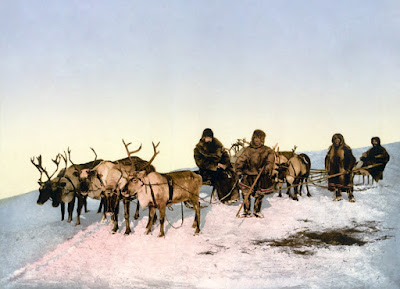Entheseal Change Analysis and the Potential for
Zooarchaeology
I have recently been learning about
entheseal analysis of human skeletal material. Entheses are locations on bone
where tendons and ligaments attach, the surface of which can vary between
individuals due to repetitive stress on the muscle being reflected on the
muscle attachment on the bone. Entheses have been analysed in bioarchaeological
contexts to look at reconstructing life histories of individuals, by looking at
whether any changes are present at particular entheses sites, and attributing
these changes to a certain physical activity.
An example of this is Yonemoto’s (2016) study of Japanese
populations in the 15th to 19th centuries, where the
effects that different occupations had on entheseal change was assessed. The
analysis showed different levels of entheseal change for different occupations,
due to different repetitive areas of stress on the body occurring depending on
what their occupation involved e.g. Fishermen who were known to load and unload
boats had high levels of entheseal change in ankle and foot joints. However as
I am more interested in zooarchaeology rather than human osteology, although I found
the case studies very interesting, I immediately began to think of how this
could be applied to animals.
Figure 1: Yonemoto’s
study of entheseal changes in Japan discovered individuals occupations such as
Fisherman, which was backed up by other evidence such as paintings.
To check whether this has been done before I conducted a
quick literature search and found a distinct lack of articles applying this
technique to animals. One study I did
find by Ninimak and Salmi (2014), looked at entheseal changes in reindeer. The
study looked a Reindeer that performed a range of different activities
including free roaming reindeer, species kept in a zoo and draught animals and
studied the entheses using the same methods you would apply to a human
skeleton. The results showed differences between all uses of the species.
Differences between zoo and free roaming reindeer were found in the upper arm
bones, interpreted as different feeding techniques. An overall higher rate of
entheseal change across all bones in the free roaming reindeer was also found,
and was interpreted as due to their
large scale migration patterns causing repetitive strain on certain muscle
attachments. Further patterns were shown in the draught reindeer with increased
entheseal change in the hind limbs, which was interpreted as repetitive strain
from pulling weights behind them e.g. a sleigh.
Figure 2: Analysis by
Ninimal and Salmi showed evidence for Reindeers being used to pull weights
behind them e.g. Sleighs. Photo: Wikipedia
I
believe that if this technique is applied more frequently to other species of
animal, zooarchaeologists could discover a lot more about past human-animal
relationships. As shown in the Reindeer case study, analysis of entheses can
show what activities the animal undertook, which is usually invisible
archaeologically. Examples of this could be the analysis of cattle entheses
which may show changes in upper limb bones due to ploughing, which is rarely
seen archaeologically. Other possibilities may include the analysis of dog
remains to identify whether they were used for hunting over long periods of
time or traction e.g. sleigh pulling, or horses which may face entheseal change
during horseback riding.
Although
problems with the recording of entheseal changes exist, due to all existing
methodologies only relating to human bone, the simple recording of the presence
or absence of entheseal change may give information about the animal’s life
history, and what it was used for in the past.
References/Further Reading
Ninimaki,
S. and Salmi, A K., 2014. Entheseal Changes in
Free-Ranging Versus Zoo Reindeer—Observing Activity Status of Reindeer. International Journal of Osteoarchaeology.
26 (2). 314 – 323.
Yonemoto,
S., 2016. Differences in the Effects of Age on the Development of Entheseal
Changes Among Historic Japanese Populations.
American Journal of Physical Anthropology. 159. 267 – 283.


No comments:
Post a Comment